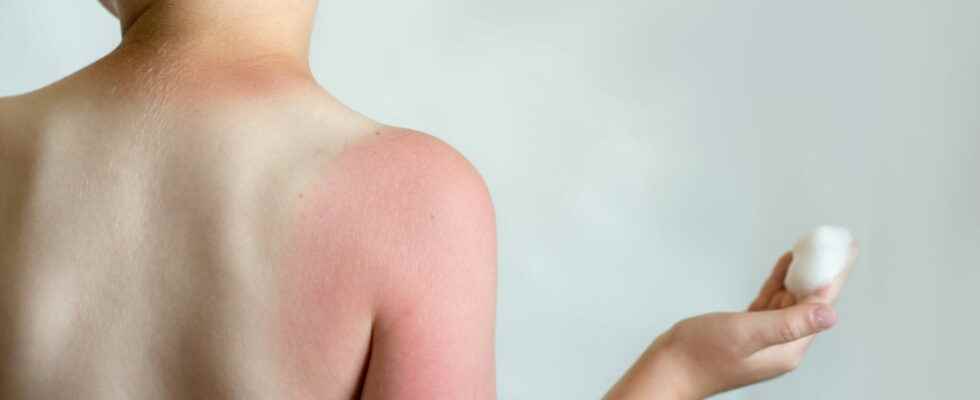Childhood sunburn predisposes you to melanoma, a serious form of skin cancer. Until puberty, the skin is thinner and the pigmentary system immature, which makes it more vulnerable to the carcinogenic effects of UV rays.
[Mise à jour le 6 juillet 2022 à 10h17] 80% of skin cancers are linked to excessive sun exposure. Childhood is a particularly risky period for the skin in the event of exposure to the sun. “Until puberty, the skin is thinner and the pigment system immature, which makes it more vulnerable to the carcinogenic effects of UV rays.“explains theNational Cancer Institute in a campaign to raise awareness of the risks of the sun for the little ones, on the eve of the 2022 summer holidays. Contrary to what parents often think, theregular application of sunscreen is not enough to protect them and does not allow them to expose themselves any longer. It is recommended do not expose children under 3 to UV rays. And in general, children should stay in the shade as much as possible.
What are the symptoms of sunburn in children?
Sunburn is a first-degree burn, caused by UVA and UVB rays from the sun. It is characterized by redness of the skin, which can be accompanied by tightness and pain when touched. In general, this skin lesion will regress spontaneously in a few days: the redness subsides and the skin begins to peel. “If these symptoms are accompanied by blisters, headache, dizziness, signs of confusion and digestive upset such as diarrhea and vomiting, it is probably a heatstroke (sunstroke), requiring emergency room consultation“comments Dr. Anne Boutemy.
What are the risks of sunburn in childhood?
“Sunburn caught in childhood predispose to melanoma later in life, this is why it is essential to protect children“, warns the pediatrician. The more repeated sunburns we have in childhoodbefore the age of 15, the greater the risk of developing melanomas in adulthood. And this, all the more so if you have a clear phototype. “Some parents are convinced of the benefits of sun exposure for their children to synthesize vitamin D. However, it is recommended to supplement children with vitamin D at a minimum until the end of growth and then continue into adulthood. It is better to have it orally because anyway, in Western countries you are never sufficiently exposed, and sun exposure is dangerous”she continues.
The first reflex to adopt to make a child’s sunburn redden is to apply cold to the affected area, either with the help of a compress, or by taking a shower or a bath. This will cool the skin and soothe the feeling of heat. To be done as long as the “fire” of the sunburn persists.
To relieve sunburn in children, it is recommended toapply Biafine® (in a thick layer until the skin refuses, by making it penetrate with a light massage and repeat 2 to 4 times a day) or Aloe Vera gel. These products allowsoothe the burn while deeply rehydrating the skin. If the pain is severe, paracetamol can be administered. At the same time, it is essential to regularly give the child something to drink to promote skin regeneration. Of course, the child should not be re-exposed to the sun before the redness has completely disappeared.
From what age can Biafine be used?
Biafine is a cream recommended to soothe burns such as sunburn. It is not a sunscreen and should not be used as a care cream on healthy skin.
► First degree burns: Apply in a thick layer until the skin refuses. Make penetrate by a light massage. Renew 2 to 4 times a day. In the event of an extensive burn, consultation with your doctor is essential. Biafine should not be applied to injured skin and wounds. In accordance with the information provided by theANSMhe this medicine should not be used in babies younger than 4 weeks old with open sores or large areas of broken or damaged skin (burns) without telling your doctor or pharmacist first.
When to consult a doctor after a sunburn?
“If the child has neurological symptoms (confusion, fatigue, drowsiness, vomiting), this means that he has had heat stroke (sunstroke). He must therefore be taken to the emergency room to be rehydrated orally or intravenously.says Dr. Anne Boutemy. While waiting for emergency services, simple actions can be taken to lower the child’s temperature: put him in the shade and lay him down, put a mist on his face, give him plenty of water to drink“.
How long does a sunburn last?
A sunburn usually fades in a few days when it is superficial. After 24 hoursit is already less painful.
The best way to prevent sunburn is:
- to seek the shade systematically
- not to expose the child from 12 p.m. to 4 p.m.
- to do to him wear covering clothes, a wide-brimmed hat and sunglasses. The physical photoprotection blocks the passage of UV rays. These are anti-UV clothing (T-shirts, swimsuits, wetsuits, leggings, etc.). Dr. Anne Boutemy recommends the long-sleeved jumpsuit to the feet with a UV hat protecting the neck. UV tents are also very effective. “The physical photoprotection remains the most effective and less chemical because the chemical barrier is harmful for the environment but also for health since it penetrates through the skin”says the specialist.
- As a plus (but not alone): put an index 50 sunscreen on uncovered areas. It is better to favor then the filters of the brands Avene and Aderma who are the best for children’s skinaccording to the pediatrician.
Thanks to Dr Anne Boutemy, pediatrician.
Source: Press release. National Cancer Institute. July 5, 2022
